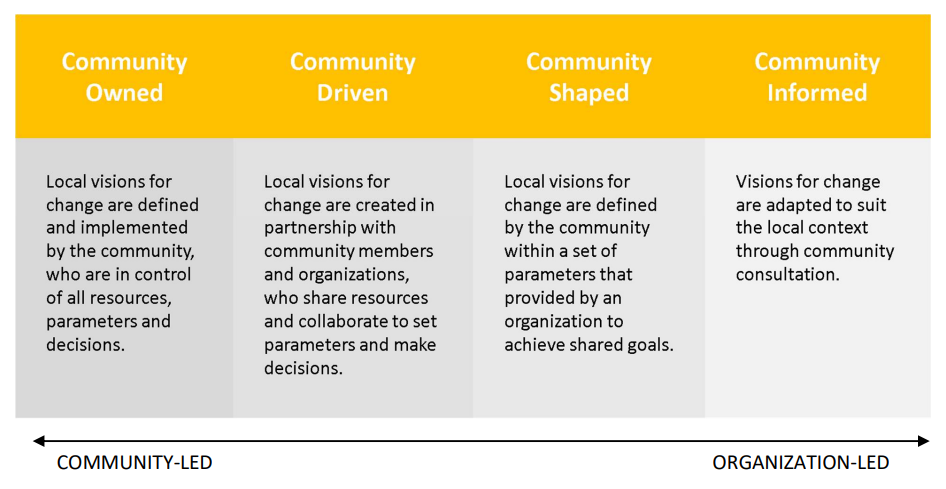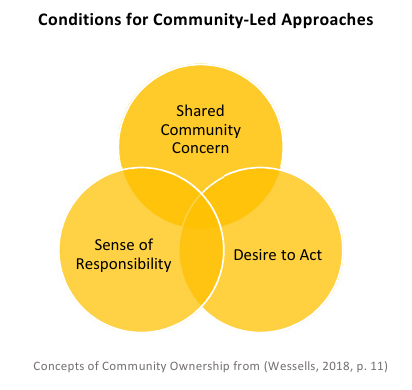Community-Led Development
There exist many definitions of community-led approaches. The discrepancy in “community-led” verbiage suggests that generally, a lot of organizations don’t pay necessary attention to this, so they tend to neglect to convey their de-facto governance model. Because open-source projects attract people from all around the world, it’s extremely important to be explicit about this.
According to the research conducted by Tamarack Institute which promotes strategies for community change, some organizations may overpromise or be disingenuous by saying that they are community-led while they don’t intend to give much power to the community, or arrogantly assume they can speak for community or know what community “actually” wants.1
This issue is quite prominent in open-source community. The vast diversity of people and different cultures which entail contrasting values, assumptions, beliefs, expectations etc. makes this extra ambiguous. Because of this, all open-source community-led projects must strive to eliminate this ambiguity.
For clarification, the previous Governance chapter discussed the aspect of control. In contrast, this chapter describes types of ownership. While these concepts may overlap, they have distinct meaning.
Types of community-led approaches

Source: Understanding Community-Led Approaches to Community Change
For our purpose in relation to Governance, let’s classify and define community-led approaches into these categories:
-
Community-owned - vision is completely defined and implemented by community itself. Community is in control of all decisions. In a hypothetically ideal world, no governance model is required here, there’s an assumption that community itself is able to effectively fulfill its vision on its own.
-
Community-driven - vision is defined and implemented by community at large. Community with its leadership and partners collaborate to make decisions. Governance is typically electoral or do-ocratic.
-
Community-shaped - vision is defined by community within the scope set forward by leadership. Leadership is in control of most decisions. Governance is typically conducted by self-appointing board or foundation-backed.
-
Community-informed - vision is adapted by community feedback and consultation. Leadership is in control of all decisions. Governance is typically founder-leader or corporate-backed.
Characteristics

Source: Understanding Community-Led Approaches to Community Change
Sense of responsibility
All types of community-led projects must have a sense of responsibility, and frankly every type of project out there regardless of whether it’s open-source or proprietary.
Ask leadership whether they are committed. If they respond that they do not feel responsible nor obligated to do anything, it’s not the project that you’re looking for, because a sense of responsibility is essential for all types community-led projects.
💡 If you feel repulsed reading above, it’s a sign that you need to develop your leadership qualities! Of course, this assumes that you’d like to lead a community-led project, and not just a single person working on a project, otherwise a sense of responsibility is not required. Even then, there exists a notion of self-responsibility. Namely, how committed you’re to your own intrinsic values and goals.
How well you are “committed” does not imply spending 8 hours a day working on a project. Rather, it’s about demonstrating how well your actions align with your words. Commitment is not time-bound; it’s mostly about adhering to the principles of your project that you created or maintain.
Bottom-up
With community-led approaches, users and contributors trust community leaders to manage a project using the “bottom-up” principle, where community holds power and makes key decisions. Decisions are mostly taken via consensus-building process. Even when community doesn’t directly make those decisions (as in community-informed approach) it’s still important for the leadership to actually reflect and satisfy community needs and be committed to fullfil its vision.
Conclusion
If you’d like to run a community-led project, the usage of decision-making “button” shouldn’t be the demonstration of your power as a lead developer or project manager. Rather, your decisions must reflect consensus of contributors and users. Otherwise, you should re-evaluate how much power you actually intend to give to community, and become either a community-shaped or community-informed project. Do convey this information explicitly without re-defining community-driven term. Don’t let potential contributors fall victim to this type of ambiguity. Strive to create an environment where actual consensus can be reached.
References
Understanding Community-Led Approaches to Community Change - By Lisa Attygalle, Tamarack Institute.